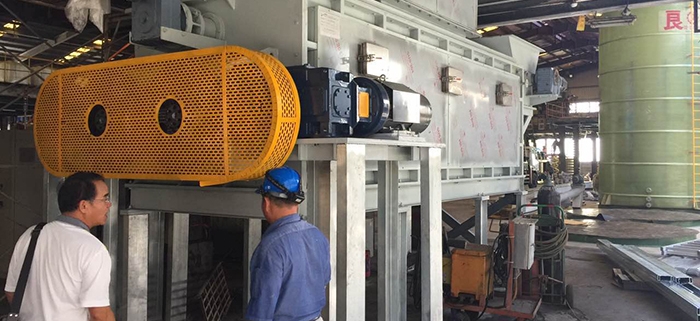The paddle dryer is a device with high thermal efficiency, low operating cost and cost saving. a jacket is arranged on the dryer cylinder, a hollow blade is arranged on the hollow shaft, and the jacket and the blade are inserted into the intercept body, and the sludge and the hot surface of the blade are fully exchanged under the stirring of the stirring blade to To achieve the purpose of drying. In terms of specific types, it is horizontal, vertical, and biaxial or quadruple. In addition, it can be divided into hot air and conductive.
The wedge-shaped blade heat transfer surface has a self-cleaning function, which can wash away the sludge adhering to the wedge surface, so that the clean heat transfer surface is maintained during operation.
Paddle dryer working principle
A hollow hollow blade is densely arranged on the hollow shaft, and the heat medium flows through the blade through the hollow shaft. The heat transfer area in the effective volume per unit is large, and the temperature of the heat medium is from -40 ° C to 320 ° C. It can be water vapor or liquid type: such as hot water and heat transfer oil. Indirect conduction heating, no air is carried away to remove heat, and heat is used to heat the material. The heat loss is only the heat dissipation to the environment through the insulation of the body. The wedge-shaped blade heat transfer surface has a self-cleaning function. The relative movement of the material particles and the wedge surface produces a scrubbing action, which can wash away the adhering material on the wedge surface, so that a clean heat transfer surface is maintained during operation. The shell of the paddle dryer is of the omega type, and two to four hollow agitating shafts are generally arranged in the casing. The housing has a sealed end cover and an upper cover to prevent material dust from leaking out and fully functioning.
The heat transfer medium passes through the rotary joint and flows through the casing jacket and the hollow agitating shaft. The hollow agitating shaft has different internal structures according to the type of the heat medium to ensure a good heat transfer effect.
The blade dryer is structurally composed of two to four blade shafts, a base, a transmission portion, and a jacketed W-shaped housing.
Paddle dryer features
(1) Since the entire drying process of the material in this type of dryer is carried out in a closed environment, organic volatile gases, odorous gases, etc. generated during the drying process can be sent to the exhaust gas treatment device for treatment. It is then discharged to the atmosphere so that it can avoid polluting the air.
(2) The paddle dryer has a compact structure, a small footprint, and a large heat transfer area per unit volume, so that the basic investment can be effectively reduced and the equipment cost can be reduced.
(3) This kind of dryer has high heat energy utilization rate, because it can effectively reduce heat loss, so it can reach more than 90% in heat utilization.
(4) In the paddle dryer, the blade is a wedge-shaped blade, so it has the function of self-cleaning, and can effectively improve the heat transfer performance and heat transfer effect of the blade. In addition, since the blade can be reverse-rotated and alternately staged, and expanded and agitated, uniformity can be achieved in heat transfer, thereby improving the heat transfer effect of the paddle dryer and improving the drying of the dryer effect.


